Panels for an apron in the kitchen: an overview of varieties and tips for choosing
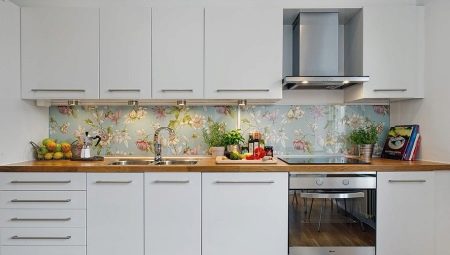
Wall kitchen panels made of PVC for tiles and with photo printing, made of MDF and other materials have gained popularity in the field of interior design. They are easy to install, have an aesthetic appearance, and make it easy to transform the interior at no extra cost. You can choose panels for an apron in the kitchen taking into account the layout of the room, the proximity of heating sources and other factors.
Some options are suitable only for use next to induction cookers, other types of interior wall panels can be placed next to sources of open fire, and not be afraid of deformation.
Before making the final choice, it is worth understanding the available range of materials, design options that are relevant in a modern kitchen.
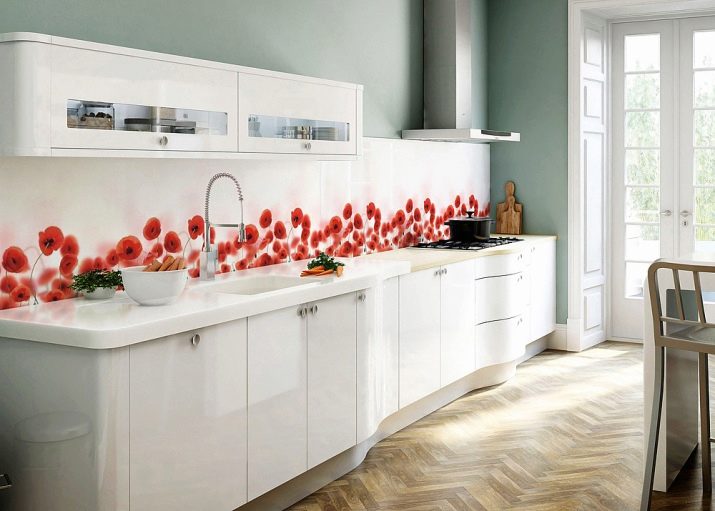

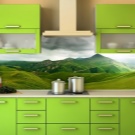
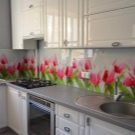
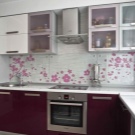
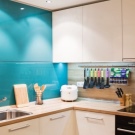
Advantages and disadvantages
Choosing panels for an apron in the kitchen, you can easily get the optimal finishing of kitchen wall surfaces - inexpensive, high-quality, safe. Among the obvious advantages of using ready-made modules for finishing the space above the work surface, a number of factors can be distinguished..
- Ease and simplicity of fastening, transportation, storage... Almost all panels are adapted to work with them alone, do not require complex manipulations. You can transform the design of your kitchen work area in one day.
- Unlimited choice of design options... You can find solid and multi-color solutions, versions with prints, 3D or photo prints. Bright pictures, original ornaments with ethnic motives, unexpected abstract drawings or strict graphics - all the most daring ideas are available for implementation.
- Affordable cost. Paneling is affordable even for people with a small renovation budget. With the right choice of material, the result will look no worse than using more expensive wall decor elements.
- Variety of options. Panels are produced from different materials - from polymer to wood-based panels, you can find the optimal solution for a kitchen with different requirements for fire safety and durability of the apron.
- Ease of renewal... An inexpensive apron based on panels is easy to replace with a new one, no less attractive. It is suitable for those who like to experiment with interior decoration.
- The ability to mask communications (pipes, wiring, ventilation ducts) when fastened to the crate.
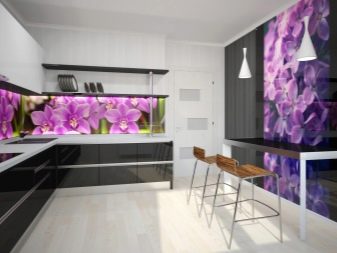
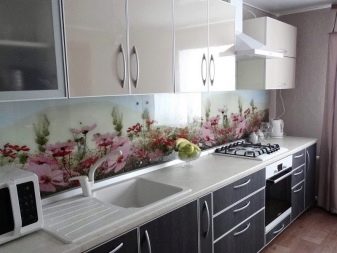
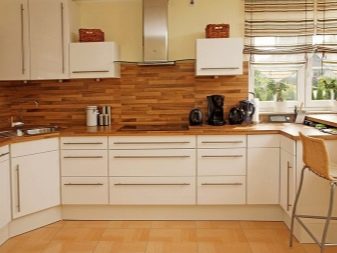
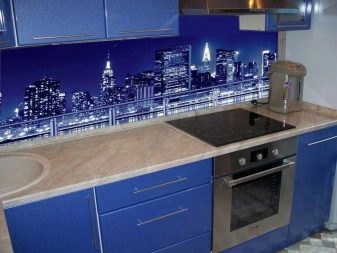
Not without its drawbacks. Many panels for an apron under the influence of external factors burn out, become brittle, and crack. Wall-mounted modules made of MDF require careful sealing of the edges. Special glass panels are quite expensive and heavy. Fiberboard easily picks up moisture, can deform. PVC panels, especially bright ones, can fade over time and lose their attractiveness.
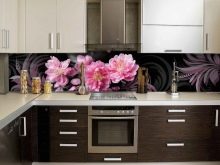
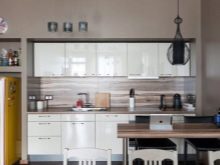
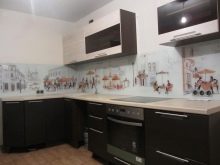
Review of materials
Panels made in the form of strips, sheets, tiles can act as a basis for the manufacture of a kitchen apron. The material for the manufacture of the base is most often plastic, wood boards made of shavings or fibers, glass and drywall.
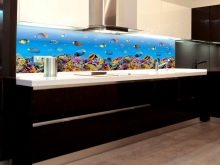
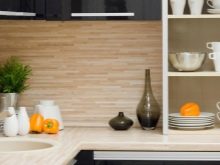
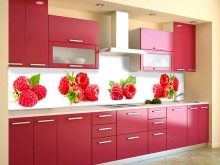
Let's analyze each of the types in more detail: how these options differ, what features and advantages they have.
Plastic panels
Quite a popular type of kitchen apron trim. For a long time, PVC panels were used only in non-residential premises. Today they are quite applicable to the kitchen. You can find options for tiles - almost indistinguishable from ceramic, or with a more complex design.
Polyvinyl chloride in the composition is quite flexible, elastic, and reproduces colors well. But it does not have heat resistance, and in terms of strength characteristics it is inferior to thicker wood-based boards.
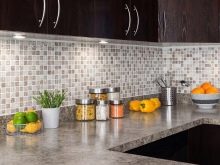
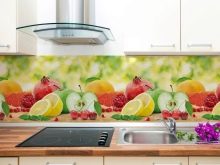
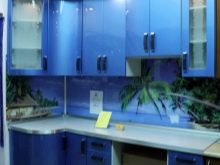
The obvious advantage of plastic is its affordability. Painted and varnished panels are inexpensive, they are not afraid of contact with water, they are practical and have a long service life. They do not change their properties under the influence of moisture and steam, they are resistant to the formation of mold and mildew. On sale you can find a wide selection of panels designed specifically for fastening in the area of the kitchen backsplash - narrow panels of considerable length are suitable here. The most stylish options are made by photo printing or by applying images using thermal film, lamination.
Panels made of plastic for the apron are not suitable for installation in the area where hobs are located, open fire sources - they are deformed by heat. In contact with sharp objects, the surface is easy to scratch or damage. Pure white plastic under the tiles turns yellow over time.

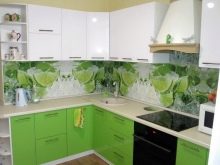

MDF
Laminated, painted, veneered MDF panels for an apron in the kitchen are produced with a standard thickness of 3-10 mm, which allows to achieve strength, to give the structure additional soundproofing properties. Narrow and long panels are not inferior to plastic in terms of decorativeness, but they are much stronger than it, they are not afraid of heat and moisture, with proper installation, they are suitable for wall cladding near the stove, sink.
MDF - boards made from medium-sized wood chips by passing through a hot press and gluing the particles using a harmless substance lignin. The material is suitable for work and dining areas, safe for health. Modern printing technologies make it possible to transfer 2D and 3D images onto the surface of the apron.
Veneered options have a thin cut of wood glued on the outside, they look spectacular and natural, they can replace the array in the eco-style interior.
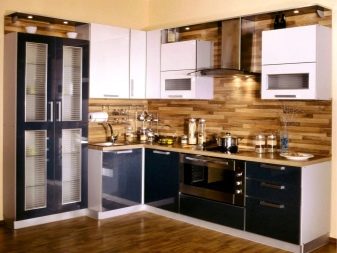
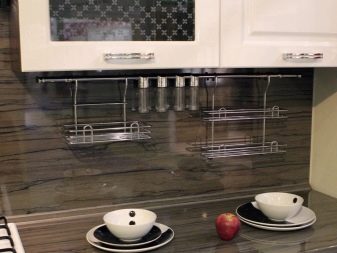
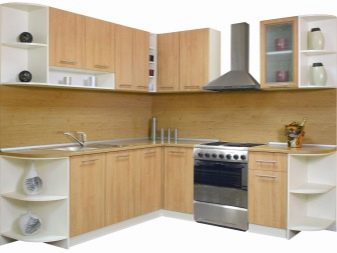
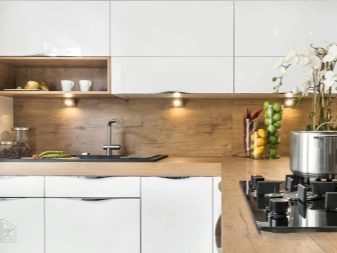
Chipboard
Plates made of laminated chipboard, although not as environmentally friendly as their MDF counterparts, are highly durable.It is worth fixing them on the wall, taking into account the massiveness of the material on a special crate. An apron made of chipboard with lamination can be made one piece with the table top - in this case it is ordered with a set, visually expanding the area of the working area.
The coating options for chipboard are much less than that of MDF. Usually these are plain solutions or imitation of natural wood, stone. The panels on the apron are contraindicated in direct contact with moisture - all edges must be protected with special overlays.
A chipboard panel is not suitable for arranging an area near heating sources, but in combination with a storage system, it looks quite harmonious.
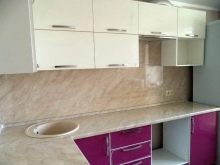
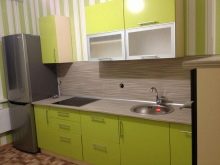
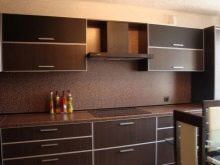
Fiberboard
Plates on a wood-fiber basis most often have a simple finish - for tiles, wood, stone. In terms of thickness and strength, they are inferior to MDF and chipboard. Such an interior panel for an apron is quite practical - you can choose an option for painting with a relief ornament, ready-made decor. Plates are easy to cut, fasten, relatively light.
But the material can deform from moisture, it is flammable, it can become a breeding ground for mold and mildew.
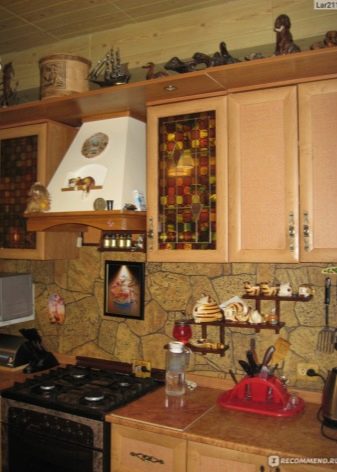
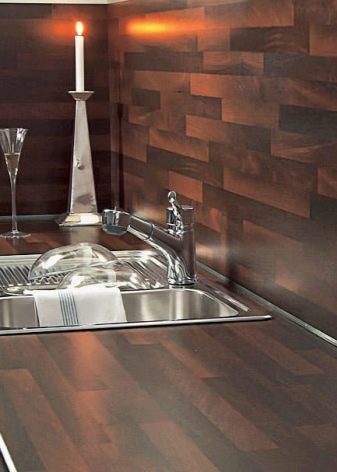
Glass
Glass apron panels - skinali - an innovative solution for the design of the kitchen space. Solid tempered or ordinary glass sheets are covered with bright images, attached to the surface of chipboard, MDF. The hardened modules are suitable for installation next to the slab. Skinals do not fade, last as long as possible, look unusual and attractive.
Under the outer glass coating in such panels there is a decor, which can be represented by a mirror surface with an original ornament, a matting base, applied with a paint layer or photo printing.
This design solution looks more impressive than plastic or wood-based panels. But they are more expensive and require careful handling.
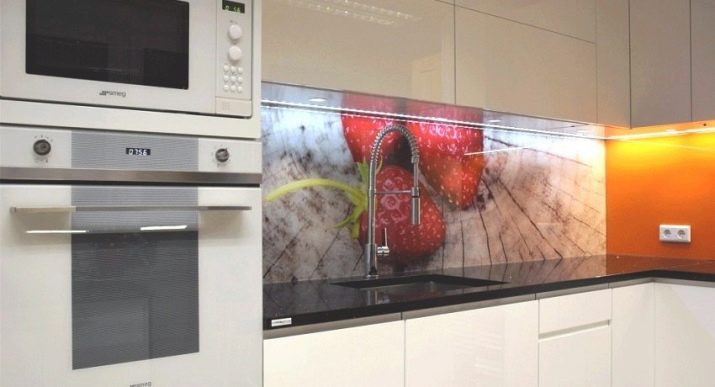
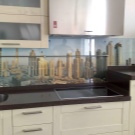
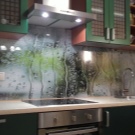
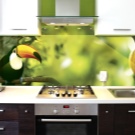
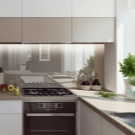
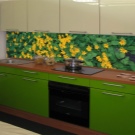
Design options
A stylish kitchen apron created with panels always becomes a source of increased attention. With its help, the kitchen room can be visually stretched or added to it volume, divided the elements of the headset, and emphasized the horizontal zoning of the area. On a panel width of 50-60 cm, a panel with a length of 2-3 m in length can be placed.
Modules with photo printing or 3D images always look bright and catchy, realistically conveying all the nuances of color and details of the picture.

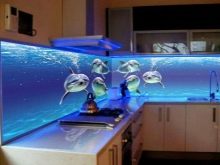
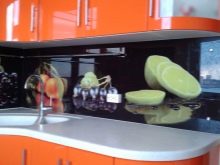
When choosing an apron design, interior panels should be selected in such a way that they do not lose their attractiveness over time. In bright, unforgiving lighting, the glossy finish will show all fingerprints and grease. It is better to use panels with a matte texture or complex heterogeneous textures here.
Meets this requirement well decorative printing with imitation of the surface of natural stone, wood, concrete, brick. This design is suitable for a Scandinavian or ethnic style kitchen.
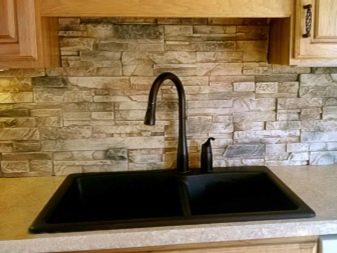
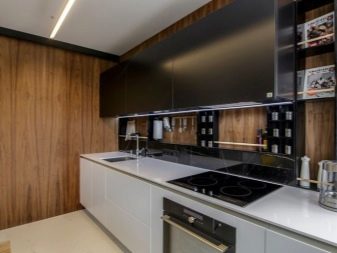
The print also looks interesting in patchwork style. Tile imitation, assembled like a patchwork quilt, looks cozy and home-like. Many manufacturers of PVC panels already use this decor in their collections. But you can order a similar ornament on MDF with lamination or skinning.
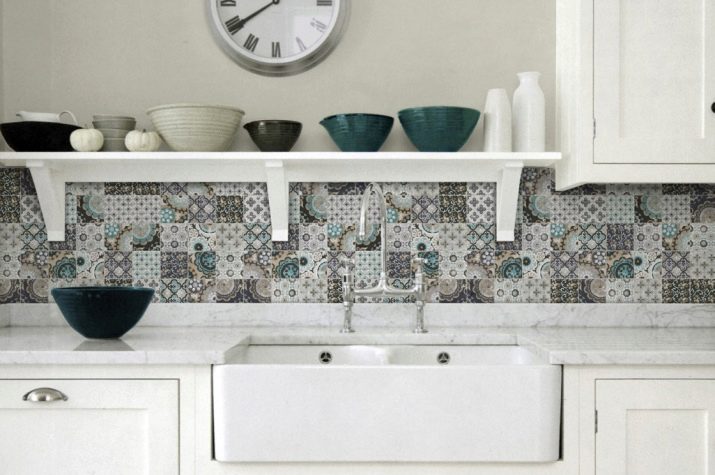
Geometric patterns are real classics in the design of kitchen aprons. The most varied solutions are offered by manufacturers of PVC-based panels. Here you can find imitation of large and small tiles, find solutions with a combination of circles, triangles and other shapes. Such an apron looks stylish both in a modern kitchen and in a minimalist interior.
The color scheme can be restrained - white, black or bright, in shades of lavender, turquoise, in sunny yellow, orange tones.
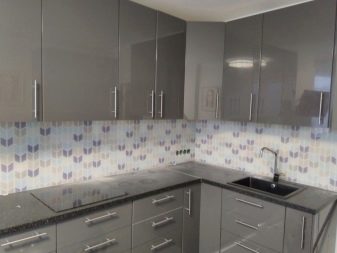
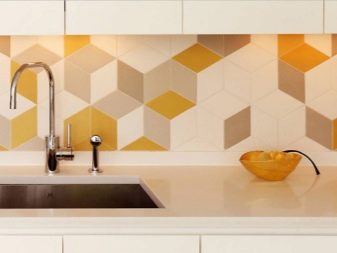
Live nature looks especially impressive on aprons in the interior of the kitchen-dining room. Here you can place bright options for decor, made in the technique of photo printing or 3D.Butterflies fluttering in the meadow, blooming tulips, seascapes with frolicking dolphins look picturesque. No less popular plots with juicy fruits, berries, cherry blossoms.
High-quality photo printing will make such a print realistic, bright and very impressive even in a budget version on PVC panels.
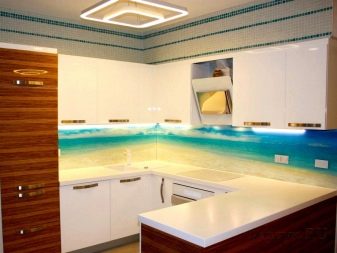
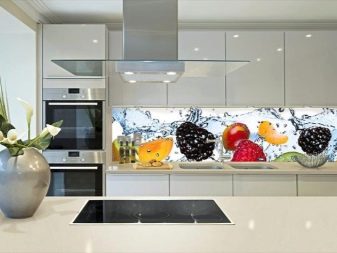
Cityscapes Is another popular option that can harmoniously fit into a bright modern kitchen, Japanese minimalism or designer high-tech. But do not forget that the spectacular panoramas of New York, Paris, London or the view of the Egyptian pyramids require appropriate framing in the interior. In combination with a budget headset, such a decor will look strange. The most spectacular options are performed on the skin.
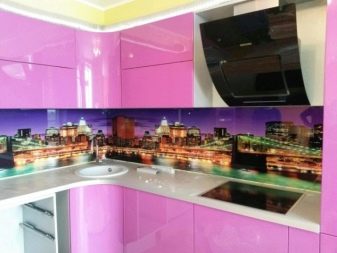
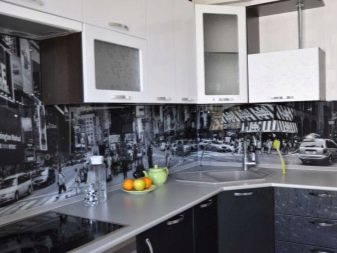
Criterias of choice
Consider the criteria that you should pay attention to when choosing high-quality panels for an apron.
- Mechanical strength... The apron is often exposed to shock loads, friction. The more reliable the material is, the longer it will last.
- The quality of execution. Apron panels must be free of foreign odors, pronounced defects. It is better to choose products that have passed certification from a well-known brand.
- Aesthetics. When choosing a wall finish in the kitchen, it is imperative to take into account the harmonious combination of decor with the design of the headset, interior design.
- Resistant to moisture. If you have to use an apron next to a sink or stove, this factor is of great importance. Otherwise, even a good drawing will not save the material from deformation.
- Convenience of configuration. A one-piece large-format panel is easier to fix than several small ones. But in a complex L-shaped or U-shaped kitchen, short type-setting modules or square tiles will be more convenient.
- Easy to care for. The best option should have a washable surface that can be cleaned of dirt with minimal effort.
- Interior status... It is better to put panels made of natural stone and valuable wood in the business class kitchen. In the economical version, more affordable materials will harmoniously look.
- Permissible wall load. If there are limitations, it is better to use the lightest apron panels that do not create additional stress on the structure.
Considering all these points, you can easily determine the best option for the apron panels that can decorate the kitchen space.
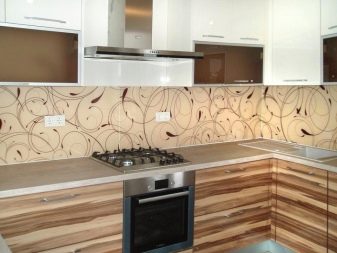
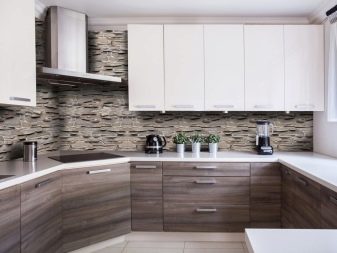
Beautiful examples
Here are some interesting ideas for inspiration.
- Apron with photo printing in the form of a black and white panorama of the city, it effectively complements the red facades of the kitchen set, chrome details and the white edging of the glazed modules. Such a solution can be realized both with the use of skinal and with conventional PVC panels with glossy coatings.
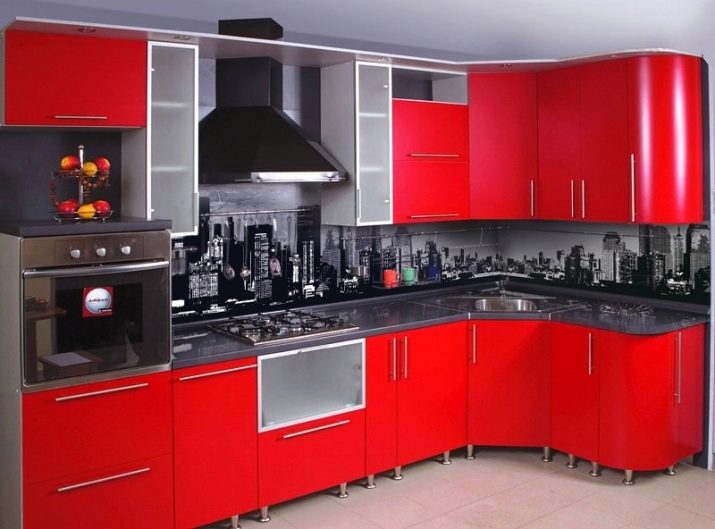
- Apron panels made of fiberboard or MDF, PVC panels great for creating bright kitchen aprons with a geometric pattern. The turquoise background color and white veins make this solution a good addition to a classic or Mediterranean style kitchen.
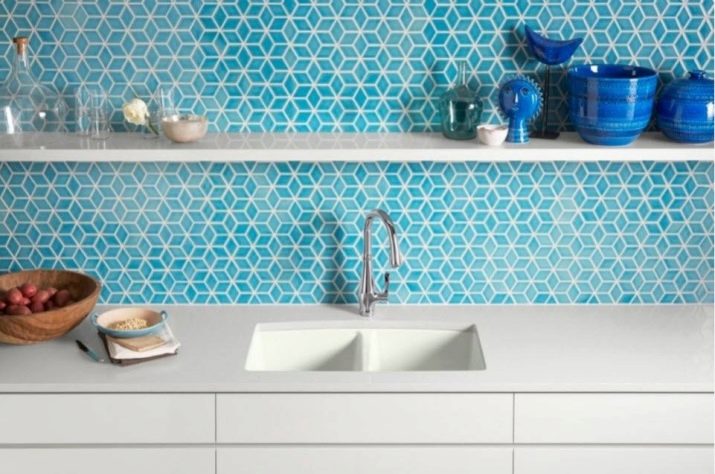
- Patchwork apron - an impeccable solution for a light, cozy kitchen of a country house. In order not to waste time on laying tiles, you can simply select a panel on the skin with the desired ornament and get the desired effect in the interior.
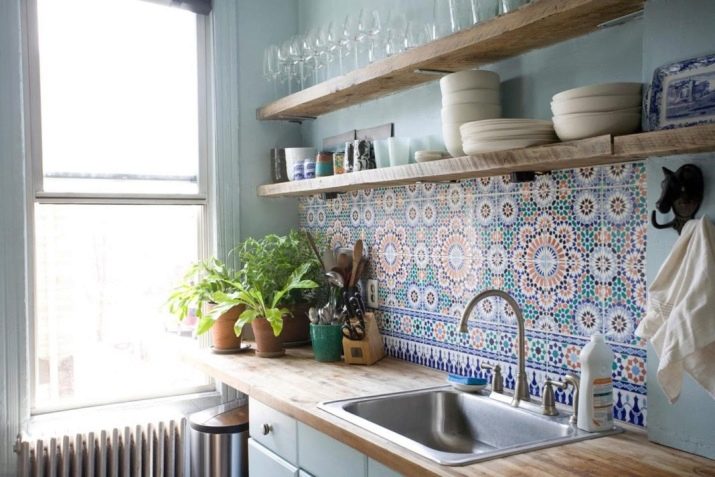
For information on how the wall panel is mounted on a kitchen apron, see the next video.








